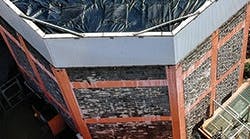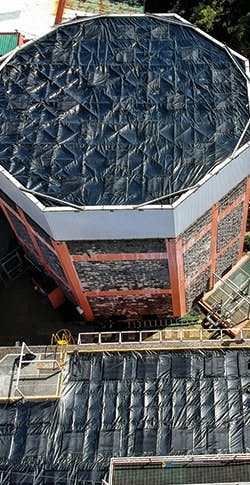After a Coca-Cola bottling plant in Brazil struggled to control odor problems at its wastewater facility with a gas scrubber system, it needed a new solution. The search for low-cost sustainable systems to control odors led the plant to a geomembrane technology with odor control filters. The Engineered Odor Control System Series is manufactured by a company in Canada and sold exclusively in North America by ANUE Water Technologies.
A geomembrane technology with carbon impregnanted filters was used to control odors at the wasterwater facility at a Coca-Cola plant in Brazil.
Many companies make geomembrane fabrics that are rubber-based and very strong. The “secret sauce” of ANUE’s odor control system “is cutting holes into the geomembrane and putting pockets for the carbon impregnated filters,” says Greg Bock, vice president and general manager of ANUE Water Technologies. This filter technology is patented as of January 2021.
Patented carbon impregnated filters
The Coca-Cola plant in Brazil is using the geomembrane technology in three applications involving trickling filters and equalization basins. The treatment plant had two rectangular reactors with rigid covers, which were still releasing odors with the odor control system it had used since 2012—hoods installed in the upflow anaerobic sludge blanket (UASB) reactors and a gas suction and exhaust system, which was directed to a composite gas scrubber with a chlorinated solution washing system, says Thiago Bassoli, plant maintenance supervisor, Coca-Cola FEMSA. Around 2017, the plant was also building a new glass-lined homogenization tank, and ANUE would install the reinforced membrane odor control system with integrated activated carbon filters on both.
ANUE geomembrane covers are custom made to fit each application and any size tank. At the Brazil bottling plant, the covers are made to fit each tank precisely, suspended above the liquid. The tight seal around the edges forces all gases toward the filters, and the filters’ porosity keeps dangerous pressure from building up in the confined space under the covers.
The membrane is supported by a cable grid and batten bars above the surface, which allows for installation in difficult locations. The filter design is engineered to allow gases and water to flow freely through the filters, but captures odor causing contaminants.
Bassoli says an improvement in odor occurred right away after installation. The plant uses a MSA ALTAIR® 5X multi-gas detector, which saw noticeable improvement after the geomembrane installation. The need for facility maintenance also decreased, improving the overall process and reducing downtime, Bassoli says.
Geomembrane: forced air applications
Bock says the majority of the applications using the geomembrane technology are passive, where gas trickles through the filters naturally. ANUE recently tried its technology in a forced air application at a plant in Chicago with a terrible odor problem. The Chicago plant had tried using misting systems for odor control with little success. Also, the chemical feed system that injected odor neutralizer to the water stream would freeze in the winters, and maintenance had to chisel ice off the system in freezing temperatures.
Two different stacks at the plant supply 30,000 cubic feet of air, and the 240 °F temperature of one stack was too hot for the geomembrane technology, so the plant and ANUE engineers worked together to blend the two discharges to cool the overall temperature to an acceptable level for the geomembrane technology.
For the new system, a filter house was built with an angled roof to reduce the snow load, and the geomembrane fabric was designed around the frame, housing about 30 filters. “Typically in an equalization basin or passive application, those filters will last a year or 18 months,” Bock says. In this application, the filters will not last as long. It has been operating about five months, and the plant has placed its first order for replacement filters. “If odor prior was 100 percent, it’s now at about 20 percent,” Bock says. “They’ve had a significant decrease in odor complaints.”
Oxygen and ozone treatment systems
ANUE also produces its own odor-controlling technologies. The company started in 2005 and has built its foundation working with municipal facilities designing oxygen and ozone treatment systems. In forced main sewer lines where wastewater goes uphill in a pressurized line, bacteria in that dark environment, where it sits for extended periods of time, wants food, which it finds plentifully in the wastewater, but the bacteria also need oxygen. Once the bacteria consume all the free oxygen, then they move onto the oxygen molecules on nitrate. Next, the bacteria move to sulfate and consume those oxygen molecules, which produces hydrogen sulfide, a dangerous gas with an unpleasant odor. As the wastewater and hydrogen sulfide leave the pressurized line, it falls into a wet well, or into screens at the wastewater plant, and the hydrogen sulfide (H2S) gas meets the moisture in the air (H2O) and becomes sulfuric acid (H2SO4), which is highly corrosive. Most applications are handled by chemically feeding nitrate into those lines to continually feed the bacteria. However, instead of monthly chemistry applications, ANUE created technology to feed oxygen into the line for the bacteria, so it never turns to the nitrate for food.
The FORSe2 technology uses an air compressor, appropriately sized for the application, depending on how much oxygen needs to be produced, the length and diameter of the line, and the altitude of the application. “I take that air compressor, and I run it through an oxygen generator,” Bock says. That pure oxygen goes into the forced main, and at the correct level keeps the line in an aerobic state, as opposed to an anaerobic state. “Bacteria has plenty of oxygen. They’re happy. The water smells as good as wastewater will smell, but you don’t have the hydrogen sulfide formation occur.”
ANUE technology can also feed ozone, in addition to oxygen, where a small quantity of ozone is generated from a side stream of oxygen. This is used in underground wet well applications, where wastewater sits. When the well fills, a pump turns on and pushes off the waste, but while it sits, it stinks. “We have the ability to put a grinder pump in the well, and we circulate that water. We’re sucking from the bottom and discharging on the top,” Bocks says. “To that, we add ozone, and what that does is it oxidizes the carbon in the water, so that lowers the bacteria uptake of the oxygen.”
The FORSe5 combines both oxygen and ozone, and the Phantom series is the small package version of that system. “It has an oxygen generator inside of the cabinet and a small air compressor inside the cabinet, and that cabinet will be two feet deep, five foot high by four foot wide. It’s got a small footprint, and that would be utilized in a wet well application,” Bock says. A grinder pump down in the wet well brings water to the top and spreads it across a spray head called a hydrosphere where ozone is injected. “We use the Phantom system in municipalities to handle fats, oils, and grease,” Bock says.
The Enviroprep System also works in wet well applications, where a grinder pump circulates water, this time through a T-shaped head with opposing flaps that spin under the water pressure. The water drops about four to five feet onto the water surface at about 40 to 50 gallons per minute. “You’re just circulating the water, but by doing that you’re breaking the surface tension of that wet well and that oxygenates the water that’s in the wet well,” Bock says. “The fat, oil, and grease get homogenized. It’s able to be sent further down to the waste treatment plant, where it can be properly removed in a dissolved air floatation system.”
These products have been used mainly in municipal applications, but Bock feels like the oxygen and ozone treatment system have a place in industrial applications. The FORSe5 system requires a substantial capital investment, but the typical payback, considering the elimination of chemical treatment costs, is about 18 to 24 months. Bocks believes protein processing plants, for example, or other industrial applications could utilize oxygen and ozone treatment in the future. “From a theoretical and technical standpoint, we believe that it has promise,” he says.
This article is part of our monthly What Works column. Read more from our monthly What Works series.



